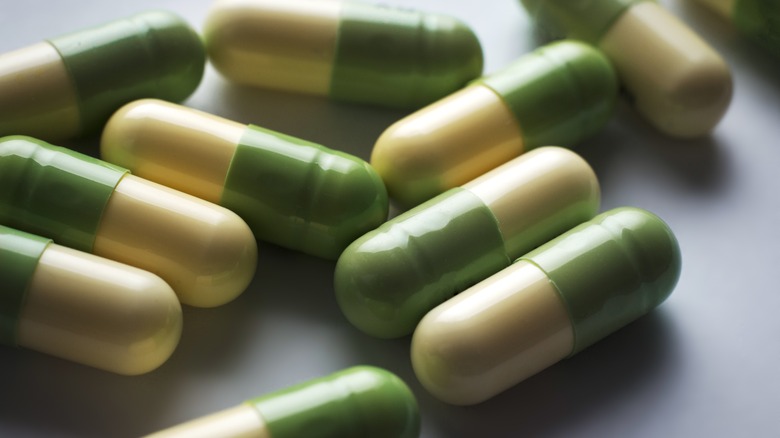What's The Difference Between SSRIs And MAOIs?
Antidepressant use is widespread in the United States. From 2015-2018, 13.2% of American adults had used them in the past month, according to the Centers for Disease Control and Prevention (CDC). Antidepressants are the top treatment for depression. And since past 12-month depression affected nearly 1 in 10 adults in 2020, knowing some key differences between major classes of medical treatment is important (via American Journal of Preventive Medicine).
There are many different types of antidepressants. Some of the most frequently prescribed antidepressants are selective serotonin reuptake inhibitors (SSRIs) such as Prozac, according to Mayo Clinic. There are also serotonin and norepinephrine reuptake inhibitors (SNRIs), such as Cymbalta and Effexor. Another type of antidepressant is monoamine oxidase inhibitors (MAOIs), which aren't as commonly used. There are also atypical antidepressants, such as Wellbutrin, and tricyclic antidepressants (TCAs), which are an older class of drug and can cause more side effects than newer drugs.
SSRIs are more commonly used
SSRIs, or selective serotonin reuptake inhibitors, are prescribed often because they tend to have fewer side effects and are more cost-effective and accessible than other treatments (via Everyday Health). However, experts aren't totally sure why they work so well. One theory is that they increase levels of neurotransmitters in the brain, which are chemicals that relay messages between nerve cells. One neurotransmitter, serotonin, helps to regulate our mood, sleep, and appetite, which might explain why SSRIs can help treat depression. Another theory is that SSRIs can improve the way that nerve cells function in the brain. Common SSRIs include Prozac, Lexapro, and Zoloft.
But they don't work the same for everyone, according to UC San Diego Health. Because our brains are all so different, an SSRI that works for one person might not work the same for another person. And while all SSRIs belong to the same class of drugs, one might work completely differently from another. Side effects can vary from person to person, as well.
MAOIs aren't prescribed as often anymore
MAOIs, or monoamine oxidase inhibitors, were the first drugs developed to treat depression in the 1950s (via Healthline). They're similar to SSRIs in that they impact the way neurotransmitters work in the brain, but they work differently. Neurotransmitters like dopamine, serotonin, and norepinephrine, also called monoamines, could be low in people with depression. But there's a chemical that naturally occurs in our bodies called monoamine oxidase that cleans up these neurotransmitters after they've been used. MAOIs work by preventing monoamine oxidase from removing neurotransmitters, helping to keep their levels in the brain steady.
But MAOIs aren't prescribed very often anymore. Monoamine oxidase not only removes neurotransmitters but also takes away tyramine, which is another chemical in the body that helps regulate our blood pressure. When MAOIs are working, they're not only keeping neurotransmitters in the brain but also enhancing levels of tyramine, which can negatively impact our blood pressure. There are also many foods that are high in tyramine, such as aged cheeses and citrus fruits, so you have to be really careful about avoiding these foods when taking MAOIs. MAOIs also tend to cause more side effects than other antidepressants on the market, which is why they're not prescribed as often anymore. But for some, they may be helpful.



